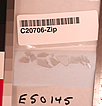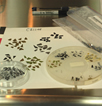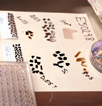The original Genesis Preliminary Assessment Plan was developed to address science collectors returned to Earth in a near nominal condition. Although the plan addressed general contingencies, such as collector contamination due to outgassing and fragmentation of collectors on re-entry, the actual events of September 8, 2004 presented a case beyond the initial scope of the plan. Therefore an addendum was developed in an attempts to address the unexpected condition of the collectors, including excessive fragmentation and heavy contamination, and to detail changes to the baseline Preliminary Assessment Plan in both scope and implementation.
The Genesis spacecraft returned to Earth on September 8, 2004, experiencing a non-nominal reentry in which both the drogue and main parachutes failed to deploy causing the capsule to impact the surface of the UTTR desert at a speed of 193 miles per hour. The impact caused severe damage to the capsule and a breach of the science canister in the field. The spacecraft was located on its side with about 50% of the capsule below the soil surface and the drogue mortar and pyrotechnic devices undeployed. The science canister was recovered and returned to the cleanroom at UTTR within approximately 8 hours of reentry. Although the ground water table did not rise to canister level before removal, damp soil and debris from the heat shield and other spacecraft components did enter the canister and contaminate collector surfaces.
The canister had to be transported in an inverted configuration to minimize collector losses. Likewise the canister was deintegrated in this configuration and nearly all collector fragments were removed at UTTR. JPL procedures document the dismantling of the canister; LANL procedures document the disassembly of the concentrator and targets; and JSC procedures, notes, and photographs document the processing, handling, condition, and inventory histories of all components.
|
| Karen McNamara assesses canister condition |
|
The objective of preliminary assessment is no different in the off-nominal case. It is to provide the science community with the information necessary to request the most useful samples for analysis. The hope is always that a “useful” sample is one in the as-received condition, however, it is often the case that samples require processing prior to allocation. This processing may include subdivision at the simplest or sample cleaning on a more complex level. The data obtained in the preliminary assessment process is critical in developing the plans for pre-allocation processing in any case.
Goals of the Intermediate Recovery Team:
In order to meet the objective of this preliminary assessment plan, the following goals have been set forth:
- Provide a complete inventory of collector materials available for scientific study. This includes: collector type, dimensions, notes on as-received condition, drawings, and photographs.
- Provide traceability of collector fragments to their parent arrays, and where possible their flight location within that array.
- Provide data on contamination levels, including particulate exposure and molecular contamination.
- Provide detailed description of damage induced by physical abrasion, chemical reaction or other relevant processes.
Condition of the Collectors:
|
Concentrator Target post-landing |
|
Concentrator Targets: The concentrator targets were recovered nearly intact and with little visible contamination beyond fine dust. The only fragmented material was the diamond on silicon quadrant, of which more than 85% was recovered in four large fragments, ranging from ~ 5 mm x 5 mm to one half of the quadrant. Much of the remainder was recovered as smaller pieces. Thus the assessment and subdivision of the targets will proceed much as in the nominal case with the possible exception of dust removal. Since the targets were inverted during science collection, the effects of on orbit outgassing should be minimal. Dust removal and the potential evaluation of molecular contamination will be addressed below.
Gold Foil Collector: Like the concentrator targets, the gold foil collector was recovered in remarkable condition. The material is in tact and compromised only by minor wrinkling of the surface. No tares were noted, although two micrometeroid impacts were observed in one corner of the sample. These should not interfere with the early science plan to allocate half of the foil for nitrogen isotope analysis. (Obviously, the half without the impacts is preferable for allocation.) This again, is quite similar to the nominal case. No direct evidence of molecular contamination was observed, though again, dust may be present. Evaluation of both of these issues is addressed in this document.
|
| Collector Array in cleanroom at UTTR hours after recovery |
|
Aluminum Collector: The polished aluminum collector was located on the impact side of the spacecraft and sustained physical damage not observed in the concentrator targets or gold foil collector. The piece is bent or curled on some edges and the overall flatness is superimposed with a wave-like ripple. The surface, in many respects, remains highly polished but there is surface scratching and more direct contact with UTTR soil in the bulk form of mud, rather than simply dust. Clearly, some additional assessment of surface cleaning may need to take place. In addition, darkening of the aluminum thermal shield supporting the aluminum collector was observed. This “browning” is observed to trace the outline of the aluminum collector though it is not clearly observed on the collector surface itself. The source of this discoloration is unclear and possibilities include: long term hydrogen exposure of the anodized material and/or outgassing and subsequent UV degradation of contaminants from other sources on the spacecraft. An approach to assessing these observations and their indications for subsequent processing of the aluminum collector are addressed in this plan.
Bulk Metallic Glass Collector: The bulk metallic glass collector was retrieved in tact from the top of the canister array deployment mechanism. It was removed by extracting the three attach screws. The collector surface shows little evidence of scratching or molecular deposition, but both will be evaluated in addition to dust removal options.
Array Collectors: The array collectors were the most seriously effected and compromised by the hard landing and canister breach. Nearly all of the collectors shattered to a greater or lesser extent. Collector survival was directly correlated to: position on the arrays with respect to shear and impact and collector identity or more precisely crystal lattice and orientation. Sapphire based collectors, for example, which have no continuous crystal cleavage plane, had superior survival rates to silicon and germanium, both of which have clean cleavage planes along their (100) orientation. (All of the silicon and germanium collectors were oriented in the (100) direction because these materials have greater purity and lower defect concentrations than other orientations.) Materials on the outer edges of the arrays, away from the shear plane, also had higher survival rate.
 |
 |
 |
 |
 |
| Sapphire Fragments Packaged at UTTR for Shipment to JSC |
|
Sorting of Collector Fragments Recovered from Canister at UTTR |
|
Collector Fragments Sorted by Material Composition |
|
Silicon on Sapphire Hexagon Wafer Found Intact After Impact |
|
Although one complete hexagon and several half hexagons were retrieved from the canister, the majority of the collectors were broken into multiple fragments (many < 5 mm x 5 mm). A limited number of these fragments remained attached to the array frame and thus could be identified unambiguously. Because the majority of the pieces were not attached at any point and as a result of the force, shear and orientation of the impact, significant collector fragment mixing between arrays occurred. Every effort was made to identify and record the found location of collector fragments, however, the majority of the pieces will need to be evaluated for thickness to unambiguously identify their parent array. This process is discussed below.
|
Cataloged pieces of lid foil recovered from impact site |
|
Capsule Lid Foil Collectors: The Lid Foil collectors were a dedicated PI experiment and as such were recovered and allocated directly to the responsible PI. As such they are not discussed here other than to note their as received condition. The center foil, center ring, and remnants of all nine conical foils were recovered. All were severely crushed and covered with UTTR dust, mud, and reentry by-products. An attempt was made to brush loose debris from the surfaces before transport from UTTR. No surface flaking of molybdenum was observed, but the rigidity of the bulk of the foil had increased dramatically, presumably due to hydrogen embrittlement. |
